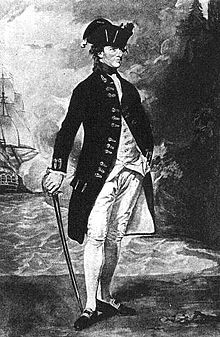Hyde Parker (Royal Navy officer, born 1739)
Sir Hyde Parker | |
|---|---|
 Admiral Sir Hyde Parker (1739–1807) after the painting by Romney | |
| Born | 1739 Devonshire, England |
| Died | 16 March 1807 (aged 67–68) London, England |
| Allegiance | |
| Service/ | |
| Rank | Admiral |
| Commands held | North Sea Fleet Leeward Islands Station Jamaica Station Baltic Fleet |
| Battles/wars | American Revolutionary War French Revolutionary Wars Napoleonic Wars |
Admiral Sir Hyde Parker (1739 – 16 March 1807) was an admiral of the British Royal Navy.
Biography
He was born in
From 1766 onwards for many years he served in the
Parker was with his father at the
In 1801 he was appointed to command the Baltic Fleet destined to break up the northern armed neutrality, with Vice-Admiral Horatio Nelson as his second-in-command. Copenhagen, the first objective of the expedition, fell in the Battle of Copenhagen on 2 April 1801 to the fierce attack of Nelson's squadron – Parker, with the heavier ships, taking little part[2] due to the shallowness of the channel.[6] At the height of the battle Parker, who was loath to infringe the customary rules of naval warfare,[6] raised the flag to disengage. Famously, Nelson ignored the order from his commander by raising his telescope to his blind eye and exclaiming "I really do not see the signal " (although this is generally accepted to be a myth). Nelson pressed on with the action and ultimately compelled the Danish forces to capitulate.[7] Parker's hesitation to advance up the Baltic Sea after his victory was later severely criticised. Soon afterwards he was recalled and Nelson succeeded him.[2] He died on 16 March 1807.[1][a]
Character assessment
In Parker's entry in the
We all respect and love Sir Hyde; but the dearer his friends, the more uneasy they have been at his idleness for that is the truth—no criminality. I believe Sir H. P. to be as good a subject as His Majesty has.[9]
Family
Parker was twice married: first, to Anne, daughter of John Palmer Boteler, and by her had three sons;[10] second, in 1800, he married Frances,[citation needed] a daughter of Admiral Sir Richard Onslow,[10] and made their home at the manor house in Benhall on the Suffolk coast.[8]
His first son – the third
Two other notable family members who fought in the Napoleonic wars are Parker's second son, John Boteler Parker, who died a major general and C.B. in 1851, and the youngest, Harry, a lieutenant in the guards, who fell at the Battle of Talavera.[10]
Notes
- ^ "Bromley mentions two portraits of Parker: one by Sir Joshua Reynolds, which was engraved by C. Townley, and the other by Romney, engraved in 1780 by J. Walker" (Laughton 1895, p. 245).
- ^ a b Rines 1920.
- ^ a b c d Chisholm 1911, p. 827.
- ^ DNB
- ^ Haydn, Joseph (1851). The Book of Dignities: Containing Lists of the Official Personages of the British Empire ... from the Earliest Periods to the Present Time ... Together with the Sovereigns and Rulers of Europe, from the Foundation of Their Respective States; the Peerage of England and Great Britain. Longmans, Brown, Green, and Longmans. p. 279. Retrieved 14 December 2016.
Admiral William O'Bryen Drury.
- ^ Cundall, p. xx
- ^ New International Encyclopedia(1st ed.). New York: Dodd, Mead.
- ^ NT staff 2013, p. 1.
- ^ a b Wilkinson 2008.
- ^ Wilkinson 2008 cites Nelson, Letters, 1.78
- ^ a b c d Laughton 1895, p. 245.
- ^ Lambert 2004.
References
- Cundall, Frank (1915). Historic Jamaica. West India Committee.
- Lambert, Andrew (2004). "Parker, Hyde (1784?–1854)". doi:10.1093/ref:odnb/21312. (Subscription or UK public library membershiprequired.)
- NT staff (13 May 2013). "Melford Hall history". The National Trust. Retrieved 15 May 2013.
- "The Parkers: a naval dynasty". The National Trust. Retrieved 15 May 2013.
- Rines, George Edwin, ed. (1920). . Encyclopedia Americana.
- Wilkinson, Clive (January 2008) [2004]. "Parker, Sir Hyde (1739–1807)". doi:10.1093/ref:odnb/21311. (Subscription or UK public library membershiprequired.)
Attribution:
- This article incorporates text from a publication now in the public domain: Chisholm, Hugh, ed. (1911). "Parker, Sir Hyde s.v. Admiral Sir Hyde Parker". Encyclopædia Britannica. Vol. 20 (11th ed.). Cambridge University Press. p. 827.
 This article incorporates text from a publication now in the public domain: Laughton, John Knox (1895). "Parker, Hyde (1739-1807)". In Lee, Sidney (ed.). Dictionary of National Biography. Vol. 43. London: Smith, Elder & Co. pp. 244–245.
This article incorporates text from a publication now in the public domain: Laughton, John Knox (1895). "Parker, Hyde (1739-1807)". In Lee, Sidney (ed.). Dictionary of National Biography. Vol. 43. London: Smith, Elder & Co. pp. 244–245.
